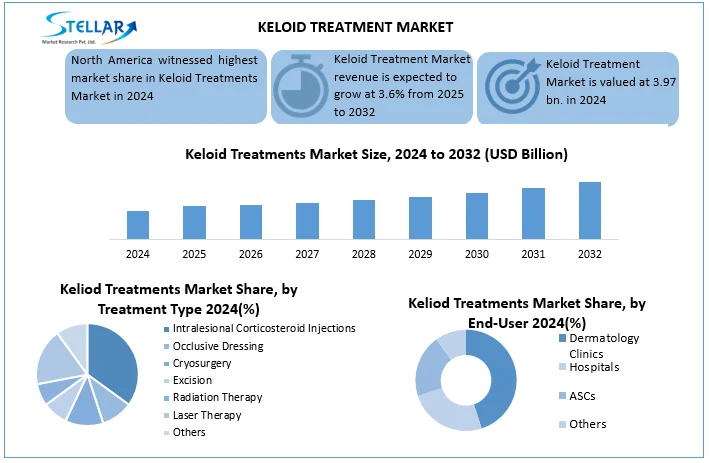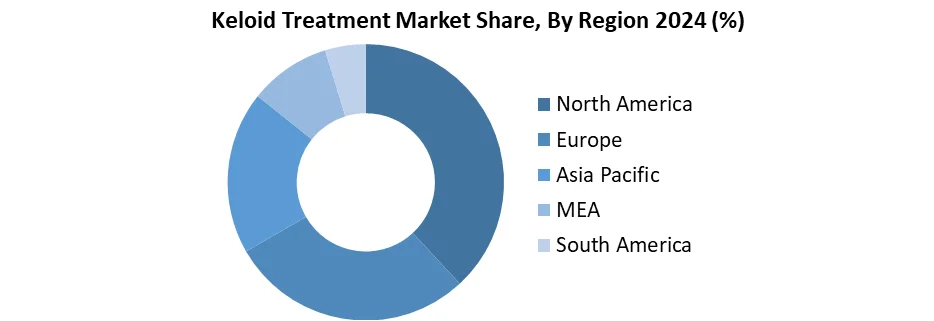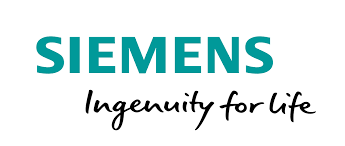Keloid Treatment Market Industry Overview, Size, Share, Growth Trends, Research Insights and Forecast (2025–2032)
Keloid Treatment Market was valued at USD 3.97 billion in 2024. Its total industry revenue is expected to grow by 3.6% from 2025 to 2032, reaching nearly USD 5.27 billion in 2032
Format : PDF | Report ID : SMR_2775
Keloid Treatment Market Overview
Keloid Treatment encompass the specialized support functions that enable the efficient trade, storage, and movement of raw materials like oil, metals, and agricultural goods. These include trading platforms, logistics networks, risk management tools, and quality certification systems that bridge producers and global markets.
Keloid Treatment Market is witnessing steady growth by their increasing aesthetic awareness and widespread availability of non-invasive solutions like silicone gels and portable light therapy devices. Rise of e commerce platforms and tele-dermatology services are further improved treatment access, mainly in emerging economies. North America leads global market by its advanced healthcare infrastructure, high demand for cosmetic care and presence of key brands like Mederma and BioCorneum.
Major players like Pfizer, Johnson & Johnson, and RXi Pharmaceuticals dominate competitive landscape with strong innovation and extensive global reach. Among end-users, dermatology clinics are growing by their specialization in skin treatments and access to advanced minimally invasive technologies followed by hospitals and ambulatory surgical centers (ASCs) for more complex cases.

To get more Insights: Request Free Sample Report
Keloid Treatment Market Dynamics
Aesthetic Trends to Drive the Keloid Treatment Market Growth
Global demand for keloid treatment is rising by its increasing focus on physical appearance and aesthetics. Growing number of cosmetic surgeries like piercings, C-sections, and tattoos often lead to keloid formation mainly among individuals with darker skin types. Social media and beauty trends are pushing younger consumers to seek flawless skin, boosting interest in a scar prevention and treatment. With a rising disposable income in developing countries like India, China, and Brazil, more people can now afford laser therapy, silicone based products, and dermatological care. Non-invasive solutions like scar creams, silicone sheets, and advanced lasertreatments are gaining popularity by their minimal risk and quicker recovery.
Consumer demographics driving the demand for keloid treatment
|
Age Group |
Characteristics |
Role in Market |
|
15–30 years (Youth & Young Adults) |
Highly image-conscious, active on social media, prone to body modifications (tattoos, piercings) and acne scars |
Primary target segment for topical products, laser therapy, and aesthetic treatments |
|
30–45 years (Working Professionals) |
Financially stable, interested in anti-aging and cosmetic upkeep, may have post-surgical or acne-related keloids |
High spenders on minimally invasive and clinic-based treatments |
|
45+ years (Mature Adults) |
Undergo more surgeries (e.g., cardiac, orthopedic, mastectomy) where keloids can form |
Seek post-operative and long-term scar management solutions |
Treatment Variability & Side Effects to Restrain the Keloid Treatment Market Growth
One of the major challenges in keloid treatment market is unpredictable efficacy and potential side effects of existing therapies. Keloid response to treatment also varies significantly across individuals by its genetic predisposition, skin type, wound location, and immune response. For instance, darker skin tones (Fitzpatrick Types IV–VI) are more prone to keloid formation and may react differently to certain laser or steroid therapies.
Keloid treatments- effectiveness, recurrence rate, and side effects
|
Treatment |
Effectiveness |
Recurrence Rate |
Common Side Effects |
|
Intralesional Steroid Injections |
Moderate to High |
33%–50% |
Skin thinning, hypopigmentation, pain at injection site |
|
Surgical Excision (alone) |
Low |
70%–100% |
Recurrence, infection, bleeding |
|
Surgical Excision + Steroids/Radiation |
Moderate to High |
10%–30% |
Wound healing delay, pain, radiation side effects |
|
Cryotherapy |
Moderate |
25%–50% |
Skin blistering, pigment loss, temporary swelling |
|
Laser Therapy (e.g., PDL, CO?) |
Moderate |
20%–45% |
Redness, burning, hyper/hypopigmentation |
Growth of Non-Invasive & At-Home Keloid Treatment to Create Opportunities in the Keloid Treatment Market
Keloid treatment market is expanding rapidly by its growing demand for non-invasive and at-home care options. Consumers prefer silicone gels, scar creams, and portable light therapy for convenience and privacy. E-commerce and teledermatology are increasing access, especially in Asia-Pacific and North America, making scar management more affordable and widely adopted across income groups.
Top Brands in At-Home Keloid Treatment
- Mederma offers Advanced Scar Gel and PM Intensive Overnight Gel, using onion extract to reduce scars effectively; it's a globally trusted brand in scar care.
- Dermatix provides Silicone Gel and Ultra Advanced Scar Formula, clinically recommended for reducing post-surgical scars with a smooth finish and improved skin texture.
- BioCorneum features SPF-infused silicone gel, uniquely combining sun protection with advanced scar treatment, ideal for healing and preventing discoloration in exposed areas.
Keloid Treatment Market Segment Analysis
Based on treatment type, Keloid Treatment market is segmented into Intralesional corticosteroid injections, occlusive dressing, cryosurgery, excision, radiation therapy, laser therapy and others. Intralesional Corticosteroid Injections segment dominated the market in 2024 and is expected to hold the largest market share over the forecast period. They are widely regarded as first-line, cost-effective, and highly accessible option for reducing a inflammation, flattening raised scars, and relieving symptoms like itching or pain. These injections, mainly triamcinolone acetonide, are commonly used dermatologists by their well established safety profile, clinical efficacy, and compatibility with a combination therapies like cryotherapy or laser. Minimally invasive nature and relatively fast results make them a preferred choice among both patients and physicians.
Based on end-user type, Keloid Treatment market is segmented into Hospitals, dermatology clinics, ASCs and others. Dermatology clinics segment dominated the market in 2024 and is expected to hold the largest market share over the forecast period. These clinics are preferred by their specialization in skin conditions and access to advanced, non invasive technologies like laser therapy, cryosurgery, and topical treatments. Patients often choose dermatology clinics for cosmetic concerns by their offer personalized care, shorter wait times and outpatient procedures. Growing popularity of med spas and aesthetic dermatology in urban areas has further boosted patient footfall, making dermatology clinics leading choice for keloid treatment.
Keloid Treatment Market Regional Analysis
North America Leads Keloid Treatment Market with Advanced Tech & High Cosmetic Demand
North America dominates global keloid treatment market by its advanced healthcare infrastructure, high aesthetic awareness, and strong consumer spending on cosmetic procedures. Region sees widespread adoption of advanced technologies like laser therapy, cryotherapy, and silicone based products. Key market players like Mederma and BioCorneum are based here, enhancing product availability and innovation. Favorable FDA approvals and insurance coverage support greater treatment access. High disposable income and growing e-commerce further boost the use of home-based scar care solutions. This combination of medical advancement, demand, and accessibility makes North America the leading region in keloid treatment.
A recent example of innovation in keloid treatment comes from Brazil, where new ASAP protocol combining hydrocolloid occlusion, monthly 5?fluorouracil/triamcinolone injections, and intense pulsed light (IPL) therapy is showing 82% success in flattening lesions, with minimal recurrence and high patient satisfaction, especially among individuals with darker skin tones.

Keloid Treatment Market Competitive Landscape
Keloid treatment market is dominated by key players like Mederma, Pfizer, Johnson & Johnson, and RXi Pharmaceuticals by their strong product innovation and global reach. Mederma leads in over the counter scar care with trusted topical gels. Pfizer and Johnson & Johnson leverage their vast dermatology and wound care portfolios, while RXi focuses on advanced RNA-based anti scarring therapies.
Sonoma Pharmaceuticals specializes in topical wound treatments, supporting its niche dominance. These companies excel by their R&D investment, strong branding, and ability to meet rising global demand for non-invasive keloid solutions.
Recent Developments in the Keloid Treatment Market
- Mederma
In May 7, 2025, featured by Allure as one of the top scar creams, highlighting Mederma Advanced Scar Gel for its onion extract formula and efficacy in reducing older scars in 2–3 months.
- Sonoma?Pharmaceuticals
In January 4, 2023, launched new office-dispense products—Regenacyn Plus, Reliefacyn Plus, and Rejuvacyn Plus—targeting keloid and hypertrophic scars with hypochlorous acid formulations.
- Sensus Healthcare
In January 30, 2025, presented its SRT-100 Vision superficial radiotherapy for keloid and skin cancer treatment at The Microcap Conference on January 30, 2025.
|
Keloid Treatment Market Scope |
|
|
Market Size in 2024 |
USD 3.97 Bn. |
|
Market Size in 2032 |
USD 5.27 Bn. |
|
CAGR (2025-2032) |
3.6% |
|
Historic Data |
2019-2024 |
|
Base Year |
2024 |
|
Forecast Period |
2025-2032 |
|
Segments |
by Treatment Type Intralesional Corticosteroid Injections Occlusive Dressing Cryosurgery Excision Radiation Therapy Laser Therapy Others |
|
by End-User Hospitals Dermatology Clinics ASCs Others |
|
|
Regional Scope |
North America- United States, Canada, and Mexico Europe – UK, France, Germany, Italy, Spain, Sweden, Russia, and Rest of Europe Asia Pacific – China, India, Japan, South Korea, Australia, Indonesia, Philippines, Malaysia, Vietnam, Thailand, Rest of APAC Middle East and Africa - South Africa, GCC, Egypt, Nigeria, Rest of the Middle East and Africa South America – Brazil, Argentina, Rest of South America |
Key Players in the Keloid Treatment Market
North America
- Mederma (New York, USA)
- Pfizer Inc. (New York, USA)
- Merck & Co., Inc. (New Jersey, USA)
- Bristol?Myers Squibb (New York, USA)
- Mylan N.V. (Canonsburg, USA)
- RXi Pharmaceuticals (Massachusetts, USA)
- Sonoma Pharmaceuticals (California, USA)
- Sensus Healthcare (Florida, USA)
- Avita Medical Inc. (New Jersey, USA)
- Valeant Pharmaceuticals (Bridgewater, USA)
- Revitol Corporation (New York, USA)
- Johnson & Johnson (New Brunswick, USA)
Europe
- Novartis AG (Basel, Switzerland)
- Hoffmann-La Roche Ltd. (Basel, Switzerland)
- GSK plc (Brentford, UK)
- AstraZeneca PLC (Cambridge, UK)
- Perrigo Company plc (Dublin, Ireland)
- Renovo Group plc (Manchester, UK)
- Alliance Pharma PLC (Yeovil, UK)
Asia-Pacific
- Sun Pharmaceutical Industries Ltd. (Mumbai, India)
- Pacific World Corporation (Delhi, India)
- Avita Medical Ltd. (Melbourne, Australia)
- Xiamen Sinocare Medical Science & Tech. Co. (Xiamen, China)
Middle East & Africa
- Molnlycke Health Care AB (Gothenburg, Sweden – active in MEA)
- Scar Heal Inc. (USA – operational via MEA partners)
South America
- Grupo Boticário (Curitiba, Brazil)
- Natura &Co (São Paulo, Brazil)
Frequently Asked Questions
Aesthetic trends, cosmetic surgeries, social media influence, and rising income in developing countries.
Intralesional corticosteroid injections – affordable, effective, and widely used.
North America – strong healthcare, high cosmetic demand, and presence of key players.
Mederma, Pfizer, J&J, RXi, Sonoma known for R&D, product range, and global reach.
1. Keloid Treatment Market Introduction
1.1. Study Assumption and Market Definition
1.2. Scope of the Study
1.3. Executive Summary
2. Global Keloid Treatment Market: Competitive Landscape
2.1. SMR Competition Matrix
2.2. Key Players Benchmarking
2.2.1. Company Name
2.2.2. Product Segment
2.2.3. End-User Segment
2.2.4. Revenue (2024)
2.2.5. Geographical Presence
2.3. Market Structure
2.3.1. Market Leaders
2.3.2. Market Followers
2.3.3. Emerging Players
2.4. Mergers and Acquisitions Details
3. Keloid Treatment Market: Dynamics
3.1. Keloid Treatment Market Trends
3.2. Keloid Treatment Market Dynamics
3.2.1. Drivers
3.2.2. Restraints
3.2.3. Opportunities
3.2.4. Challenges
3.3. PORTER’s Five Forces Analysis
3.4. PESTLE Analysis
3.5. Regulatory Landscape by Region
3.6. Key Opinion Leader Analysis For the Global Industry
3.7. Analysis of Government Schemes and Initiatives for Industry
4. Keloid Treatment Market: Global Market Size and Forecast by Segmentation (by Value in USD Billion) (2024-2032)
4.1. Keloid Treatment Market Size and Forecast, By Treatment Type (2024-2032)
4.1.1. Intralesional Corticosteroid Injections
4.1.2. Occlusive Dressing
4.1.3. Cryosurgery
4.1.4. Excision
4.1.5. Radiation Therapy
4.1.6. Laser Therapy
4.1.7. Others
4.2. Keloid Treatment Market Size and Forecast, By End-User (2024-2032)
4.2.1. Hospitals
4.2.2. Dermatology Clinics
4.2.3. ASCs
4.2.4. Others
4.3. Keloid Treatment Market Size and Forecast, By Region (2024-2032)
4.3.1. North America
4.3.2. Europe
4.3.3. Asia Pacific
4.3.4. Middle East and Africa
4.3.5. South America
5. North America Keloid Treatment Market Size and Forecast by Segmentation (by Value in USD Billion) (2024-2032)
5.1. North America Keloid Treatment Market Size and Forecast, By Treatment Type (2024-2032)
5.1.1. Intralesional Corticosteroid Injections
5.1.2. Occlusive Dressing
5.1.3. Cryosurgery
5.1.4. Excision
5.1.5. Radiation Therapy
5.1.6. Laser Therapy
5.1.7. Others
5.2. North America Keloid Treatment Market Size and Forecast, By End-User (2024-2032)
5.2.1. Hospitals
5.2.2. Dermatology Clinics
5.2.3. ASCs
5.2.4. Others
5.3. North America Keloid Treatment Market Size and Forecast, by Country (2024-2032)
5.3.1. United States
5.3.1.1. United States Keloid Treatment Market Size and Forecast, By Treatment Type (2024-2032)
5.3.1.1.1. Intralesional Corticosteroid Injections
5.3.1.1.2. Occlusive Dressing
5.3.1.1.3. Cryosurgery
5.3.1.1.4. Excision
5.3.1.1.5. Radiation Therapy
5.3.1.1.6. Laser Therapy
5.3.1.1.7. Others
5.3.1.2. United States Keloid Treatment Market Size and Forecast, By End-User (2024-2032)
5.3.1.2.1. Hospitals
5.3.1.2.2. Dermatology Clinics
5.3.1.2.3. ASCs
5.3.1.2.4. Others
5.3.2. Canada
5.3.2.1. Canada Keloid Treatment Market Size and Forecast, By Treatment Type (2024-2032)
5.3.2.1.1. Intralesional Corticosteroid Injections
5.3.2.1.2. Occlusive Dressing
5.3.2.1.3. Cryosurgery
5.3.2.1.4. Excision
5.3.2.1.5. Radiation Therapy
5.3.2.1.6. Laser Therapy
5.3.2.1.7. Others
5.3.2.2. Canada Keloid Treatment Market Size and Forecast, By End-User (2024-2032)
5.3.2.2.1. Hospitals
5.3.2.2.2. Dermatology Clinics
5.3.2.2.3. ASCs
5.3.2.2.4. Others
5.3.3. Mexico
5.3.3.1. Mexico Keloid Treatment Market Size and Forecast, By Treatment Type (2024-2032)
5.3.3.1.1. Intralesional Corticosteroid Injections
5.3.3.1.2. Occlusive Dressing
5.3.3.1.3. Cryosurgery
5.3.3.1.4. Excision
5.3.3.1.5. Radiation Therapy
5.3.3.1.6. Laser Therapy
5.3.3.1.7. Others
5.3.3.2. Mexico Keloid Treatment Market Size and Forecast, By End-User (2024-2032)
5.3.3.2.1. Hospitals
5.3.3.2.2. Dermatology Clinics
5.3.3.2.3. ASCs
5.3.3.2.4. Others
6. Europe Keloid Treatment Market Size and Forecast by Segmentation (by Value in USD Billion) (2024-2032)
6.1. Europe Keloid Treatment Market Size and Forecast, By Treatment Type (2024-2032)
6.2. Europe Keloid Treatment Market Size and Forecast, By End-User (2024-2032)
6.3. Europe Keloid Treatment Market Size and Forecast, by Country (2024-2032)
6.3.1. United Kingdom
6.3.1.1. United Kingdom Keloid Treatment Market Size and Forecast, By Treatment Type (2024-2032)
6.3.1.2. United Kingdom Keloid Treatment Market Size and Forecast, By End-User (2024-2032)
6.3.2. France
6.3.2.1. France Keloid Treatment Market Size and Forecast, By Treatment Type (2024-2032)
6.3.2.2. France Keloid Treatment Market Size and Forecast, By End-User (2024-2032)
6.3.3. Germany
6.3.3.1. Germany Keloid Treatment Market Size and Forecast, By Treatment Type (2024-2032)
6.3.3.2. Germany Keloid Treatment Market Size and Forecast, By End-User (2024-2032)
6.3.4. Italy
6.3.4.1. Italy Keloid Treatment Market Size and Forecast, By Treatment Type (2024-2032)
6.3.4.2. Italy Keloid Treatment Market Size and Forecast, By End-User (2024-2032)
6.3.5. Spain
6.3.5.1. Spain Keloid Treatment Market Size and Forecast, By Treatment Type (2024-2032)
6.3.5.2. Spain Keloid Treatment Market Size and Forecast, By End-User (2024-2032)
6.3.6. Sweden
6.3.6.1. Sweden Keloid Treatment Market Size and Forecast, By Treatment Type (2024-2032)
6.3.6.2. Sweden Keloid Treatment Market Size and Forecast, By End-User (2024-2032)
6.3.7. Russia
6.3.7.1. Russia Keloid Treatment Market Size and Forecast, By Treatment Type (2024-2032)
6.3.7.2. Russia Keloid Treatment Market Size and Forecast, By End-User (2024-2032)
6.3.8. Rest of Europe
6.3.8.1. Rest of Europe Keloid Treatment Market Size and Forecast, By Treatment Type (2024-2032)
6.3.8.2. Rest of Europe Keloid Treatment Market Size and Forecast, By End-User (2024-2032)
7. Asia Pacific Keloid Treatment Market Size and Forecast by Segmentation (by Value in USD Billion) (2024-2032)
7.1. Asia Pacific Keloid Treatment Market Size and Forecast, By Treatment Type (2024-2032)
7.2. Asia Pacific Keloid Treatment Market Size and Forecast, By End-User (2024-2032)
7.3. Asia Pacific Keloid Treatment Market Size and Forecast, by Country (2024-2032)
7.3.1. China
7.3.1.1. China Keloid Treatment Market Size and Forecast, By Treatment Type (2024-2032)
7.3.1.2. China Keloid Treatment Market Size and Forecast, By End-User (2024-2032)
7.3.2. S Korea
7.3.2.1. S Korea Keloid Treatment Market Size and Forecast, By Treatment Type (2024-2032)
7.3.2.2. S Korea Keloid Treatment Market Size and Forecast, By End-User (2024-2032)
7.3.3. Japan
7.3.3.1. Japan Keloid Treatment Market Size and Forecast, By Treatment Type (2024-2032)
7.3.3.2. Japan Keloid Treatment Market Size and Forecast, By End-User (2024-2032)
7.3.4. India
7.3.4.1. India Keloid Treatment Market Size and Forecast, By Treatment Type (2024-2032)
7.3.4.2. India Keloid Treatment Market Size and Forecast, By End-User (2024-2032)
7.3.5. Australia
7.3.5.1. Australia Keloid Treatment Market Size and Forecast, By Treatment Type (2024-2032)
7.3.5.2. Australia Keloid Treatment Market Size and Forecast, By End-User (2024-2032)
7.3.6. Indonesia
7.3.6.1. Indonesia Keloid Treatment Market Size and Forecast, By Treatment Type (2024-2032)
7.3.6.2. Indonesia Keloid Treatment Market Size and Forecast, By End-User (2024-2032)
7.3.7. Malaysia
7.3.7.1. Malaysia Keloid Treatment Market Size and Forecast, By Treatment Type (2024-2032)
7.3.7.2. Malaysia Keloid Treatment Market Size and Forecast, By End-User (2024-2032)
7.3.8. Philippines
7.3.8.1. Philippines Keloid Treatment Market Size and Forecast, By Treatment Type (2024-2032)
7.3.8.2. Philippines Keloid Treatment Market Size and Forecast, By End-User (2024-2032)
7.3.9. Thailand
7.3.9.1. Thailand Keloid Treatment Market Size and Forecast, By Treatment Type (2024-2032)
7.3.9.2. Thailand Keloid Treatment Market Size and Forecast, By End-User (2024-2032)
7.3.10. Vietnam
7.3.10.1. Vietnam Keloid Treatment Market Size and Forecast, By Treatment Type (2024-2032)
7.3.10.2. Vietnam Keloid Treatment Market Size and Forecast, By End-User (2024-2032)
7.3.11. Rest of Asia Pacific
7.3.11.1. Rest of Asia Pacific Keloid Treatment Market Size and Forecast, By Treatment Type (2024-2032)
7.3.11.2. Rest of Asia Pacific Keloid Treatment Market Size and Forecast, By End-User (2024-2032)
8. Middle East and Africa Keloid Treatment Market Size and Forecast (by Value in USD Billion) (2024-2032)
8.1. Middle East and Africa Keloid Treatment Market Size and Forecast, By Treatment Type (2024-2032)
8.2. Middle East and Africa Keloid Treatment Market Size and Forecast, By End-User (2024-2032)
8.3. Middle East and Africa Keloid Treatment Market Size and Forecast, by Country (2024-2032)
8.3.1. South Africa
8.3.1.1. South Africa Keloid Treatment Market Size and Forecast, By Treatment Type (2024-2032)
8.3.1.2. South Africa Keloid Treatment Market Size and Forecast, By End-User (2024-2032)
8.3.2. GCC
8.3.2.1. GCC Keloid Treatment Market Size and Forecast, By Treatment Type (2024-2032)
8.3.2.2. GCC Keloid Treatment Market Size and Forecast, By End-User (2024-2032)
8.3.3. Egypt
8.3.3.1. Egypt Keloid Treatment Market Size and Forecast, By Treatment Type (2024-2032)
8.3.3.2. Egypt Keloid Treatment Market Size and Forecast, By End-User (2024-2032)
8.3.4. Nigeria
8.3.4.1. Nigeria Keloid Treatment Market Size and Forecast, By Treatment Type (2024-2032)
8.3.4.2. Nigeria Keloid Treatment Market Size and Forecast, By End-User (2024-2032)
8.3.5. Rest of ME&A
8.3.5.1. Rest of ME&A Keloid Treatment Market Size and Forecast, By Treatment Type (2024-2032)
8.3.5.2. Rest of ME&A Keloid Treatment Market Size and Forecast, By End-User (2024-2032)
9. South America Keloid Treatment Market Size and Forecast by Segmentation (by Value in USD Billion) (2024-2032)
9.1. South America Keloid Treatment Market Size and Forecast, By Treatment Type (2024-2032)
9.2. South America Keloid Treatment Market Size and Forecast, By End-User (2024-2032)
9.3. South America Keloid Treatment Market Size and Forecast, by Country (2024-2032)
9.3.1. Brazil
9.3.1.1. Brazil Keloid Treatment Market Size and Forecast, By Treatment Type (2024-2032)
9.3.1.2. Brazil Keloid Treatment Market Size and Forecast, By End-User (2024-2032)
9.3.2. Argentina
9.3.2.1. Argentina Keloid Treatment Market Size and Forecast, By Treatment Type (2024-2032)
9.3.2.2. Argentina Keloid Treatment Market Size and Forecast, By End-User (2024-2032)
9.3.3. Colombia
9.3.3.1. Colombia Keloid Treatment Market Size and Forecast, By Treatment Type (2024-2032)
9.3.3.2. Colombia Keloid Treatment Market Size and Forecast, By End-User (2024-2032)
9.3.4. Chile
9.3.4.1. Chile Keloid Treatment Market Size and Forecast, By Treatment Type (2024-2032)
9.3.4.2. Chile Keloid Treatment Market Size and Forecast, By End-User (2024-2032)
9.3.5. Rest Of South America
9.3.5.1. Rest Of South America Keloid Treatment Market Size and Forecast, By Treatment Type (2024-2032)
9.3.5.2. Rest Of South America Keloid Treatment Market Size and Forecast, By End-User (2024-2032)
10. Company Profile: Key Players
10.1. Mederma (New York, USA)
10.1.1. Company Overview
10.1.2. Business Portfolio
10.1.3. Financial Overview
10.1.4. SWOT Analysis
10.1.5. Strategic Analysis
10.1.6. Recent Developments
10.2. Pfizer Inc. (New York, USA)
10.3. Merck & Co., Inc. (New Jersey, USA)
10.4. Bristol Myers Squibb (New York, USA)
10.5. Mylan N.V. (Canonsburg, USA)
10.6. RXi Pharmaceuticals (Massachusetts, USA)
10.7. Sonoma Pharmaceuticals (California, USA)
10.8. Sensus Healthcare (Florida, USA)
10.9. Avita Medical Inc. (New Jersey, USA)
10.10. Valeant Pharmaceuticals (Bridgewater, USA)
10.11. Revitol Corporation (New York, USA)
10.12. Johnson & Johnson (New Brunswick, USA)
10.13. Novartis AG (Basel, Switzerland)
10.14. Hoffmann-La Roche Ltd. (Basel, Switzerland)
10.15. GSK plc (Brentford, UK)
10.16. AstraZeneca PLC (Cambridge, UK)
10.17. Perrigo Company plc (Dublin, Ireland)
10.18. Renovo Group plc (Manchester, UK)
10.19. Alliance Pharma PLC (Yeovil, UK)
10.20. Sun Pharmaceutical Industries Ltd. (Mumbai, India)
10.21. Pacific World Corporation (Delhi, India)
10.22. Avita Medical Ltd. (Melbourne, Australia)
10.23. Xiamen Sinocare Medical Science & Tech. Co. (Xiamen, China)
10.24. Molnlycke Health Care AB (Gothenburg, Sweden)
10.25. Scar Heal Inc. (USA – operational via MEA partners)
10.26. Grupo Boticário (Curitiba, Brazil)
10.27. Natura &Co (São Paulo, Brazil)
11. Key Findings
12. Analyst Recommendations
13. Keloid Treatment Market: Research Methodology
















